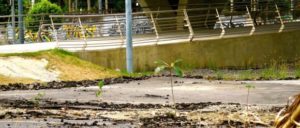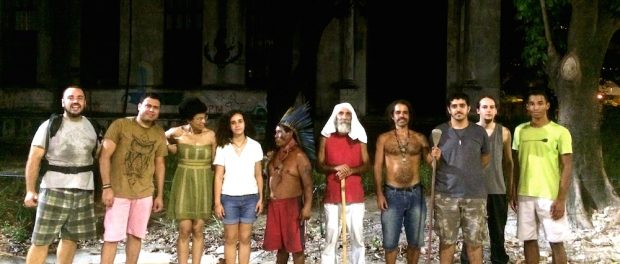An intimate group sits on two wooden benches in a Rio de Janeiro, Brazil parking lot, discussing methods of reforestation and invasive species in Brazilian forests. This is part of a three-day workshop called “Reforestation Experience”.
It’s being held in the heart of Rio’s urban core at a place called Aldeia Maracanã. This is the name of the indigenous community occupying the terrain since 2006. They’ve been forcibly evicted numerous times, but they keep returning to their restorative mission.
But this isn’t like any reforestation effort you’ve ever seen. One could call it post-disaster urban reforestation. The disaster was the 2016 Rio Olympics. Now that its near-total failure to live up to its urban revitalization promises has been well-documented, a group of indigenous folks are helping reclaim the abandoned, now-rotting, hyper-expensive facilities.
“The pedestrian bridge over there cost R$14 million,” says Paulo César Vidal, a supporter of the indigenous community. “But no one ever uses it.” The half-billion-dollar (U.S.) Maracanã stadium has become “a ghost stadium,” as Vidal put it. “The people who built it–Marcelo Odebrecht, Eike Batista, Sérgio Cabral–they are all in prison. Everything is paralyzed.”
 Now he carries water in plastic bottles to irrigate the small plants that are shyly growing in the crevices that have been broken at the edge of the asphalt: corn, pumpkin, wild cabbage, among others.
Now he carries water in plastic bottles to irrigate the small plants that are shyly growing in the crevices that have been broken at the edge of the asphalt: corn, pumpkin, wild cabbage, among others.
It is a difficult business, since there is no running water and sometimes the site goes for weeks without rain. To access water, community members cross two major roads and climb down a concrete channel. Sometimes a nearby gas station provides water. That is why building a rainwater basin is part of the workshop, too.
And one advantage of the poorly executed construction works in the run-up to the Olympics is that in some places the asphalt is already falling apart without any human influence.
Korubo points out the ant trail at his feet: “Look, we have a lot of ants living here. This one is carrying a leaf. They are already helping us with the reforestation.” Even if it takes some time to grow a forest here, he’s optimistic: “The indigenous people have more than 500 years experience resisting. We will stay.”
The community is looking for donations of 1000 seedlings, in case you’d like to help.
See full article by Lisa Hollenbach in Rioonwatch + photo credits.

